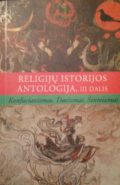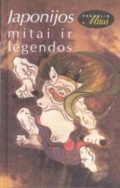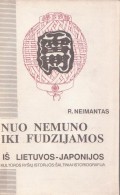
Authors:
Venclova, Tomas
Published on:
2003
Publisher:
Baltos Lankos
From the travel diaries made book, the readers can feel through the eyes of the author far Asian countries, like Japan, Korea, or China and Tibet. The book introduce us with these countries closer and lively. Author visits those places in which he has personal intrest, most of the time exploring cultural monuments or aspects of civilization. Each day spent in the country is always new for the author and he spends each day fully to feel the country as much as possible. Sometimes the author gets into funny situations or writes ironic comments, thereby not hiding his discovery happiness and difficulties he experience while travelling. More

Published on:
2002
Authors of the articles: Vygandas Aleksandravičius, Antanas Andrijauskas, Rasa Andriušytė-Žukienė, Vaclovas Bagdonavičius, Jonas Balčius, Audrius Beinorius, Rūta Guzevičiūtė, Valdas Jaskūnas, Dalius Jonkus, Stanislovas Juknevičius, Česlovas Kalenda, Auksė Kapočiūtė, Vladimir Korobov, Bronislovas Kuzmickas, Basia Nikiforova, Aistė Niunkaitė-Račiūnienė, Marija Oniščik, Loreta Poškaitė, Dainius Razauskas, Oresta Rėgalaitė, Vytautas Rimša, Vytautas Rubavičius, Dalia Marija Stančienė, Aivaras Stepukonis, Regimantas Tamošaitis, Daiva Tamošaitytė, Hidemichi Tanaka, Vytautas Tumėnas, Algis Uždavinys, Gintautas Vyšniauskas.
More

Published on:
2002
Publisher:
Vaga
Loreta Poškaitė – sinologist, orientalist, religious scholar, who has written lots of articles about Asia’s religion, mostly about Daoism. Based on her articles, in the year of 2002 the third volume of “Anthropology of the history of religions” about Confucianism, Daoism and Shintoism was published. Book is divided into three parts. Every part consists of introductory article about one of the religions, the fragments from the original “holy” book, or religion founder thoughts. More

Published on:
2002
Publisher:
Algimatas
This book would be handy to anyone because it explicitly explores a millennia of Chinese expertise in finding harmony between the body and the soul, the secret foundations to wellness, happiness and love. It requires to take into account the cycles of time and the provisions of one’s sex life, and most importantly, being in harmony with nature and the universe.
Chinese philosophy does not hide any ideas or abstract truths. Their philosophy is the ability to act duly at any moment, More

Authors:
Andrijauskas, Antanas
Published on:
2001
“Traditional Japanese Aesthetics and Art” is one of the first Western books covering Japanese aesthetic history from the early ages to the end of the XIX century. Japanese aesthetics, unlike that of India and China, does not have ancient traditions extending over thousands of years. It is more sensitive to external influences, to changes. The evolution of aesthetic thought in the Land of the Rising Sun gave birth to a world of unique categories, to distinctive principles of aesthetic understanding and art appreciation. In no other country on earth have aesthetic feeling and artistic values been able to take such firm root in everyday life. Most assuredly, the historical mission of the Japanese people is to exalt beauty and art. One of the most distinctive features of Japanese culture and aesthetic consciousness is that those areas of human creative expression which remain marginal in other cultures acquire extreme importance in Japan and become the focus of intense aesthetic reflection and artistic creation.

Published on:
1998
Publisher:
Mintis
It is widely known that one of the most complicated religious system is the Japanese one, while their mythology is also considered to be one of the most various mythologies in the world.
As it is said in the prologue of “Japanese Myths and Legends”, in Japan like in no other country myths are still vivid and real nowadays, because the polytheistic system of religions of the Japanese nation is based on them. This, as well as the origin of the religion, the classification of gods and deities and even the impact of the mythology to the modern structure of society, is revealed in the book. However, this book is not a simple collection of myths and their variations, because it reveals not only the pantheon of gods, but also the influence of Buddhism to the local religions as well as its dynamics and importance to the creation of the hierarchy system of the society when the origins of the aristocratic kin and families is explained. Moreover, the book is based on such ancient written sources of Japan as “Kojiki” (古事記), „Fudoki“ (風土記), „Nihon Ryōiki“ (日本霊異記) and more. More

Authors:
Neimantas, Romualdas
Published on:
1996
Publisher:
Orientas
Romualdas Neimantas is the writer, the doctor of history science, one of the most prominent explorer of Eastern cultures, Lithuania‘s and Eastern cultural interactions, also known as a person, who devoted his whole life for East Asia region, cognition, exploration and travelling. Author in the book “The golden dragon“ not only talks about Daoizm which is one of the oldest filosophy and religion in China but also tries to find a unique way how to perceive China. Having consideration in that, author refers to his old acquintance professor Lin Bo thoughts. Professor claims, that “China is the dragon, who has thousands of faces. If you want to understand China, you have to find a dragon… The golden dragon who is the body, the soul and the blood of China.“ The main goal in this book is to find the Golden dragon which lies in Chinese philosophy, art and perception of the world. More

Authors:
Neimantas, Romualdas
Published on:
1994
The author describes Japanese culture, art, literature, introduces to its traditions and lifestyle through his own impressions of travels to Japan, as well as, using documentary materials.

Authors:
Neimantas, Romualdas
Published on:
1994
Publisher:
Valstybinis leidybos centras
Romualdas Neimantas introduces Japanese culture based on his own experience in the book called „World in the tea cup“. Author is very impressed by the traditions, art and history of the „Land of the Rising Sun“. R. Neimantas describes the most outstanding places and people while travelling through the entire Japan. He also includes some dialogues between the Japanese and himself about various topics, such as art, the tea ceremony or the history of Japan. The book gets you closer to the … More

Authors:
Neimantas, Romualdas
Published on:
1992
Publisher:
Orientas
This book author introduces us with Lithuania Japan culture communication’s history, the most important sources and extensive bibliography. In the beginning is mentioned Nichonbashi bridge, it’s importance to Japan: ‘All roads lead to Nichonbashi’. This is the first original attempt to present Lithuania -Japan culture communication’s history facts. One of the most important thing that disturbed communication was Japan isolation from the world and the Iron Curtain which … More










